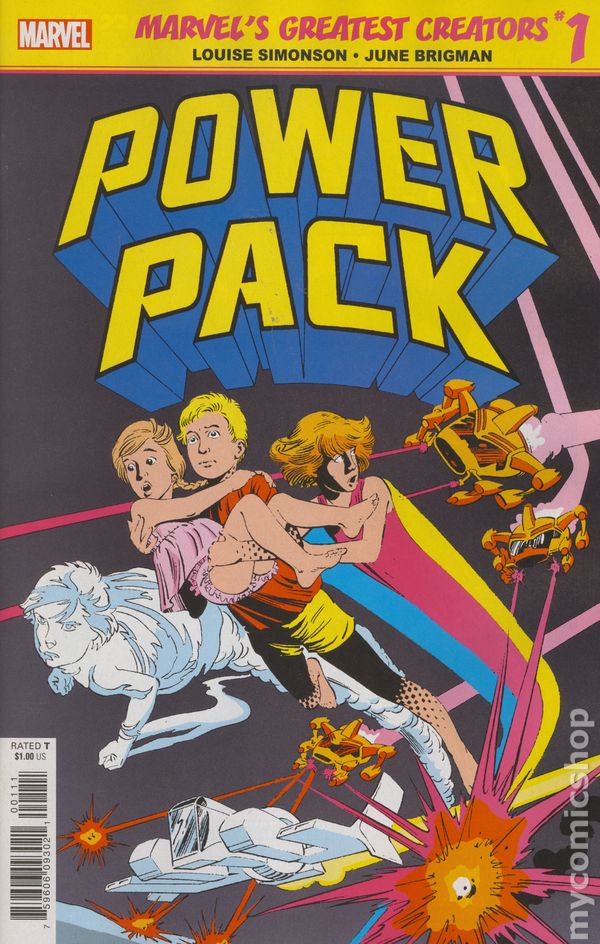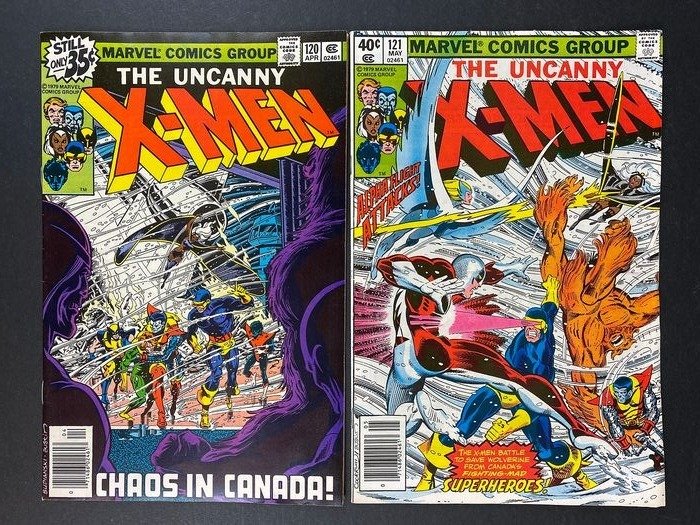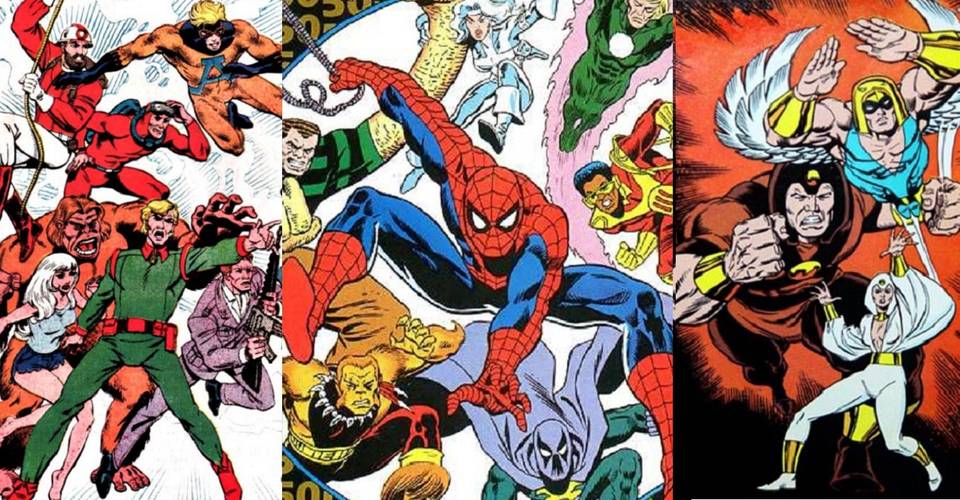This essay falls into the category of "shower thoughts I decided couldn't be made into a quick social media post, but didn't really have time to develop right away. I was musing about how it is that superhero (and to a lesser extent, supervillain) teams form and reform. I ended up with five basic categories, each of which has a distinct set of answers to the following questions:
1. Was the team formed on purpose?
2. Did some or all of the members have a connection prior to forming the team?
3. Did the team origin coincide with the individual origins?
Now, with three yes/no/maybe questions, you'd think there'd be more than five categories, but some of the options just don't happen very often, or they blend together enough to not be distinct. I suppose you could find at least one team for each of the 8 yes/no combinations, or even for each of the yes/no/maybe combinations, but I'm going to stick with the five more or less solid types that I came up with before breakfast.
If a team is around long enough, there's a good chance at least one of its rosters will fall under every one of these types, or at least three or four of them. Especially if they get adapted to other media and that medium prefers a tighter origin story.
Type 1: Thrown Together By A Common Origin
 | ||
| Sadly, the artist was cryofrozen. |
It can blur into Type 3 if some or all actually had powers before they met, and the Big Event is just their reason to take up the cape. For instance, the original Guardians of the Galaxy were mostly just typical if talented members of their races, thrown together in a rebellion against the Badoon. Or the Legion of Super-Heroes, who (in some versions) weren't out to be heroes necessarily but foiling the assassination attempt on R.J. Brande thrust the role upon them. They hadn't been superheroes before that, even though they already had their powers.
Additionally, the event that gave them powers or otherwise turned them into superheroes/villains could have been engineered by someone deliberately recruiting a team (Type 4 or 5), without making it clear they were doing so. Either as a retcon (Niles Caulder being revealed as the source of the accidents that gave the original Doom Patrol their powers; Loki later claiming to have gotten the Avengers together on purpose), or built in from the start (live action Doom Patrol adaptation, which started from the premise that Niles was behind it all).
Type 2: Formed from Pre-Existing Connections
 |
| Julie's in college, Katie didn't age. |
The Fantastic Four, Power Pack, the Marvel Family (some versions), and so forth. These people were already a team of sorts before they got their powers, whether they were a traditional family, some sort of found family, just friends, or even merely coworkers. Usually they gain their powers in a common event, but sometimes they drift apart, get separate origins, and then reunite as a superteam. Unlike the common origin teams above, they don't really need a reason to stick together after their first outing as a superteam, they already have connections that bring them together.
Of course, friendships fade, families break up; there's no guarantee that this sort of team will stay together. They just have an advantage in that respect that the more ad hoc sorts of team lack. If a writer wants to bring them back together after a breakup, it's usually easier to find reasons. The reason doesn't even have to involve their superheroing.
This can easily overlap with some of the other types, of course. The common origin story (Type 1) is the most common way the family/friends teams become superheroes. Sometimes members of a powered family become a team in response to some crisis (Type 3, IIRC ClanDestine sort of had that happen) or in order to meet some need (Type 4 or 5, some Inhumans groupings or subgroups of gods).
Type 3: Thrown Together in Reaction to a Common Threat
 |
| Later versions focused on Starro. |
Teams like this tend to be formed of existing superheroes, such as the Avengers forming to fight Loki or the Justice League of America teaming up to fight the Apellaxians (well, technically this was told in flashback, #1 just had them already as a team with no particular explanation). Other times, they don't really have solo careers prior to their team-forming incident, or they're really obscure characters being given a spotlight, like the Liberty Legion forming in the pages of the Invaders (all of them were previous solo properties in the 1940s, but these were essentially new versions of the characters).
As with Type 1 teams, they need to find a reason to stay together after the original incident is resolved, assuming it ever is. Often, it's no more complicated than realizing they're stronger together than apart and that there will be other threats that no one of them can face alone. Sometimes the initial incident is revealed to be part of a larger plot, so they stick together until the larger plot is dealt with (in the case of the Liberty Legion, the larger plot was World War II).
This is also a pretty common way to bring together a new lineup for an existing team, or to "get the band back together" and reassemble a previous roster. The Avengers have broken up, so someone rallies a bunch of heroes together under the banner of the Avengers to face a returning threat. A Great Beast menaces Canada after Alpha Flight was disbanded, so Heather Hudson puts out the call for any former Alphans still listening. The original X-Men have been captured by a living island, so Professor X assembles an all-new, all-different-but-with-Cyclops-on-it team to rescue them. The Big Four disband the JLA, so Martian Manhunter goes to Detroit to found a new JLA. All the existing Justice League teams get killed off or disbanded so Morrison...er, Batman reassembles the Big Four. And so forth.
In both new teams and revived teams, there's often one or two people who don't stick around past the original crisis. The Hulk bailed on the original Avengers lineup. Sunfire wasn't interested in actually joining the Uncanny X-Men. A lot of the Avengers teams (like the one with Mr. Fantastic and Invisible Woman on it) broke up almost immediately. There was an entire Fantastic Four lineup that had one story and then completely disbanded (Spider-Man, Wolverine, gray Hulk, and Ghost Rider) once the regular team was available again.
Type 4: Formed To Face A Coming Threat or Task
 |
| Byrne discovers snowstorm backgrounds. |
Sometimes, a team is recruited or manipulated into forming for a specific threat that is known in advance, as opposed to being a reaction to an ongoing threat, or to undertake a particular task. For instance, while part of an ongoing program (Type 5), the original Alpha Flight active roster was put together for a single mission: get Wolverine back from the X-Men. Other times, it's more a case of someone knowing a major threat is coming, and putting together a team to be ready for it (they may or may not tell the team this point during the recruiting pitch). It's good for a one-shot or a miniseries, but unless the threat is very distant and needs a lot of preparation, it won't hold a team together for long. After the Big Bad is dealt with, the team runs into many of the same problems as thrown-together teams do as far as staying together. The fact they already faced more than a single action together might help, but lies told by their mentor/founder might hurt.
The looming threat is also used a lot in revamping teams, if the person bringing together a new version knows in advance that the team will be needed, and some teams initially appearing to be filed under Type 3 might have been more due to planning than just due to reacting. This could come from a revelation of some manipulation going on (the members are allowed to think they met by chance), or it could just be revealing more background and only the reader (and maybe the public in-story) thought the initial meeting was by chance...the team already knew they'd be working together, but for whatever reason made it look like they just happened to all respond to the same emergency.
A variant of this is really common for supervillain teams, which is "The Job." A team is pulled together to execute a single theft, or assassination, or grift. The Sinister Six formed specifically to kill Spider-Man. The Thunderbolts formed as part of an elaborate world domination plan. The Legion of Super-Rejects formed to get revenge on the Legion of Super-Heroes. Sometimes the team sticks together despite their defeat, because they recognize they came pretty close to success and next time might be the charm.
Schools for powered individuals tend to qualify as Type 4, where the looming threat is the students themselves if left to their own devices. Once they are no longer considered a danger to themselves and others, they graduate. Most end up on some sort of team after that (often a Type 5 that is connected to the school), others just go solo or don't become heroes at all.
Type 5: Formed to Face Whatever Comes
 |
| "Why does Spectre HAVE a resume?" |
Sometimes, an individual or an organization sets out to form a superteam without there being a single threat in mind, rather because the world is getting dangerous and a team is needed. It might be a reaction to a crisis, but it starts up after the crisis has been resolved, and does not involve many or any of the heroes who dealt with it...your basic "Superman saved us, but what if he's busy next time?" contingency plan. The recruited team might be fairly small but potent (Marvel's Illuminati, formed in response to the Kree/Skrull War reaching Earth), it could be large and inclusive (the All-Star Squadron, which in some versions was basically Roosevelt asking every hero to join up; Department H in which basically every Canadian superhero was asked to be a part in some way at some point), it could even be an institution of long standing (Green Lantern Corps, Shi'ar Imperial Guard).
These teams always contain some element of suspicion in them, from divided loyalties (does the team do what's right, or what their sponsors tell them to do?) to questions of motivation (do the little blue dudes really have my world's interests in mind?) and even concerns that they're working for the bad guys. Their existence is often at the sufferance and whims of their sponsors, with changing political winds or inscrutable alien priorities resulting in the team being disbanded or reformed at seemingly random intervals.
When this is used for villainous teams, it's usually in the context of hostile nations/worlds (Yellow Lantern Corps, Power Skrull Corps) or the enemies of established hero teams (Legion of Doom, Masters of Evil) rather than long term freelance villain teams (the Serpent Society's "unionized" version being a notable exception). Evil Corporations who have a regular stable of mercenaries who work for them may fall into this category, but their teams tend to be single-job Type 4 sorts (guard this installation, retrieve this asset, etc).
While the students of a school for supers would be considered to have been gathered for a specific threat (Type 4), any faculty of the school might count as an ongoing general team, in that they face a series of student groups, plus any outside forces that might attack the school. If the school is meant more as a way to recruit for another team, though, the students could be considered in the Type 5 variety of team (for instance, the students in Gamma Flight and Beta Flight, who hoped to one day graduate to Alpha Flight).
Bonus Type 6: Origin? What Origin?
Numerous, if not necessarily memorable, are the teams who just sort of show up with no explanation. For instance, the Justice League of America took a while to get around to explaining how the team formed. Sometimes you can infer their origins (a villain team that shows up to fight the heroes is probably Type 3 if nothing is mentioned, a team in common uniforms is probably Type 5, or at least has a fashion consultant), but often the reason you don't find out how they formed is that this wasn't deemed important to the story, and either the writer didn't care enough to use them again, or they weren't popular enough to get enough issues for an origin to be established. If the team ever shows up again, more information might be forthcoming, of course.
Dvandom, aka Dave Van Domelen, is an Associate Professor of Physical
Science at Amarillo College, maintainer of one of the two
longest-running Transformers fansites in existence (neither he nor Ben
Yee is entirely sure who was first), is fully COVID-immunized, is an occasional science advisor in fiction,
and part of the development team for the upcoming City of Titans MMO.




